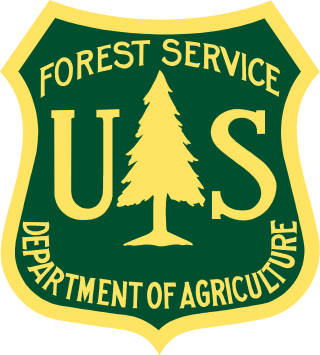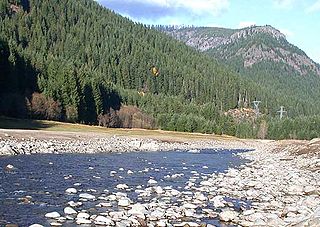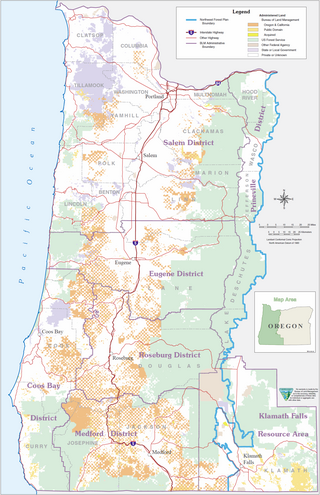Related Research Articles

The United States Forest Service (USFS) is an agency within the U.S. Department of Agriculture that administers the nation's 154 national forests and 20 national grasslands covering 193 million acres (780,000 km2) of land. The major divisions of the agency are the Chief's Office, National Forest System, State and Private Forestry, Business Operations, as well as Research and Development. The agency manages about 25% of federal lands and is the sole major national land management agency not part of the U.S. Department of the Interior.

In the United States, national forest is a classification of protected and managed federal lands that are largely forest and woodland areas. They are owned collectively by the American people through the federal government and managed by the United States Forest Service, a division of the United States Department of Agriculture. The U.S. Forest Service is also a forestry research organization which provides financial assistance to state and local forestry industry. There are 154 national forests in the United States.

Brush is a Statutory City located in Morgan County, Colorado, United States. The city population was 5,339 at the 2020 United States Census. Brush is a part of the Fort Morgan, CO Micropolitan Statistical Area.

The Tongass National Forest in Southeast Alaska is the largest U.S. National Forest at 16.7 million acres. Most of its area is temperate rain forest and is remote enough to be home to many species of endangered and rare flora and fauna. The Tongass, which is managed by the United States Forest Service, encompasses islands of the Alexander Archipelago, fjords and glaciers, and peaks of the Coast Mountains. An international border with Canada runs along the crest of the Boundary Ranges of the Coast Mountains. The forest is administered from Forest Service offices in Ketchikan. There are local ranger district offices located in Craig, Hoonah, Juneau, Ketchikan, Petersburg, Sitka, Thorne Bay, Wrangell, and Yakutat.

Wood easily degrades without sufficient preservation. Apart from structural wood preservation measures, there are a number of different chemical preservatives and processes that can extend the life of wood, timber, and their associated products, including engineered wood. These generally increase the durability and resistance from being destroyed by insects or fungi.

The Willamette National Forest is a National Forest located in the central portion of the Cascade Range of the U.S. state of Oregon. It comprises 1,678,031 acres (6,790.75 km2). Over 380,000 acres are designated wilderness which include, seven major mountain peaks. There are also several National Wild and Scenic Rivers within the forest. The forest is named for the Willamette River, which has its headwaters in the forest. The forest headquarters are located in the city of Springfield. There are local ranger district offices in McKenzie Bridge, Detroit, Sweet Home, and Westfir.

A steeplechase is a distance horse race in which competitors are required to jump diverse fence and ditch obstacles. Steeplechasing is primarily conducted in Ireland, the United Kingdom, Canada, United States, Australia, and France. The name is derived from early races in which orientation of the course was by reference to a church steeple, jumping fences and ditches and generally traversing the many intervening obstacles in the countryside.

The General Revision Act of 1891, also known as the Forest Reserve Act of 1891, was a federal law signed in 1891 by President Benjamin Harrison. The Act reversed previous policy initiatives, such as the Timber Culture Act of 1873, which did not preclude land fraud by wealthy individuals and corporations. The acquisition of vast mineral and timber resources in the Western United States was often cited as a governing motive for such individuals and corporations to claim land rights for future settlement and resource depletion activities. The legacy of the General Revision Act of 1891 is frequently credited as its serving as a catalyst to a series of federal land reform initiatives, notably under President Theodore Roosevelt. From the Reclamation Act of 1902 to the formation of the United States Forest Service in 1905, the General Revision Act of 1891 acted as a critical first piece of federal legislation granting increased plots of publicly allotted land and decreased extraction rights to privately held western land owners in the early 20th century.
The following outline is provided as an overview of and guide to forestry:
Title 16 of the United States Code outlines the role of conservation in the United States Code.
The Lacey Act of 1900 is a conservation law in the United States that prohibits trade in wildlife, fish, and plants that have been illegally taken, possessed, transported, or sold.
Wind power in Ohio has a long history, and as of 2016, Ohio has 545 megawatts (MW) of utility-scale wind power installations installed, responsible for 1.1% of in-state electricity generated. Over 1000 MW more were under construction or pending approval. Some installations have become tourist attractions. There has been a sudden increase in generating capacity, as the total wind power capacity in the state was just 9.7 MW in 2010. By 2019, there were 738 MW of capacity, which generated 1.71% of Ohio's electricity.

The Timber Culture Act was a follow-up act to the Homestead Act. The Timber Culture Act was passed by Congress in 1873. The act allowed homesteaders to get another 160 acres (65 ha) of land if they planted trees on one-fourth of the land, because the land was "almost one entire plain of grass, which is and ever must be useless to cultivating man."

The Caribou Wilderness is a federally designated wilderness area created by the Wilderness Act of 1964 and is part of the National Wilderness Preservation System. It is located 60 miles (97 km) east of Redding in the state of California, United States. The Caribou Wilderness comprises 20,546 acres (83.15 km2) and is adjacent to the east side of Lassen Volcanic National Park. Although the park is surrounded by Lassen National Forest, it is managed separately by the National Park Service, whereas the U.S. Forest Service manages the wilderness.
San Gabriel National Forest was established as the San Gabriel Forest Reserve by the United States General Land Office in California on December 20, 1892 through a proclamation order by President Benjamin Harrison. With and area of 555,520 acres (2,248.1 km2), it was the first federal reserve in the state of California.
South-Central Timber Development v. Wunnicke, 467 U.S. 82 (1984), was a United States Supreme Court case in which the Court held unconstitutional Alaska's inclusion of a requirement that purchasers of state-owned timber process it within state before it was shipped out of state. According to a plurality opinion by Justice White, Alaska could not impose "downstream" conditions in the timber-processing market as a result of its ownership of the timber itself. The opinion summarized "[the] limit of the market-participant doctrine" as "allowing a State to impose burdens on commerce within the market in which it is a participant, but [to] go no further. The State may not impose conditions [that] have a substantial regulatory effect outside of that particular market."

The Oregon and California Railroad Revested Lands, are approximately 2,600,000 acres (1,100,000 ha) of land located in eighteen counties of western Oregon. Originally granted to the Oregon & California Railroad to build a railroad between Portland, Oregon and San Francisco, California, the land was reconveyed to the United States government by act of Congress in 1916 and is currently managed by the United States Bureau of Land Management.
The Sahara Woods State Fish and Wildlife Area is a 4,100-acre (1,700 ha) state park owned and operated by the Illinois Department of Natural Resources (IDNR). It is located in Saline County, five miles west of the small city of Harrisburg.

The Empire Fire was a wildfire that burned in Yosemite National Park in California in the United States. The fire was reported on August 1, 2017 and was caused by lightning. It burned 8,094 acres (33 km2), before it was fully contained on November 27. The fire affected recreational activities in the national park.
The McSweeney-McNary Act of 1928 is an article of American legislation that was enacted on May 22, 1928. The law created the directive to implement "…a comprehensive survey of the present and prospective requirements for timber and other forest products of the United States." The Act was sponsored by Senator Charles L. McNary from Oregon and Senator John Sweeney from Ohio.

